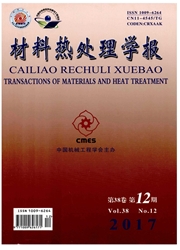

 中文摘要:
中文摘要:
透射电镜观察表明,Al-4.11%Cu二元合金中θ′相在等径角挤压(ECAP)强变形中发生反复的弯曲变形,形成了亚结构,并从亚结构界面处开始发生溶解,而θ相则发生了折断和破碎,并从破碎θ粒子的尖角处发生溶解。X射线衍射及小角度X射线散射测试结果表明,θ′相粒子随强变形溶解得比θ快,θ′相粒子在尺寸较大时即开始随强变形溶解。热力学分析表明,θ′相在强变形中因为自身的应变增加了系统的应变能和粒子回溶的驱动力,促使其在强变形中的溶解。而θ相的溶解则是因为破碎粒子尖锐菱角表面能的增加造成的。研究表明,析出相粒子应变能与表面能都是强变形诱导析出相粒子回溶的驱动力,尤其是应变能的作用更大。
 英文摘要:
英文摘要:
TEM image shows that repeated bending deformation of θ' plates occurred in the process of equal-channel angular pressing(ECAP) of Al-Cu binary alloy, which led to formation of substructure in θ' plates, and subsequently dissolution of θ' phase occurred at interface of the substructure, while θ particles were broken and fragmentized, and dissolution occurred at the sharp edge of the fragmentized θ particles. The results of X-ray diffraction and small angle X-ray scattering suggested that θ' particle dissolved more rapidly than θ particle during ECAP deformation and θ' particle started to dissolve when particle size was still greater. Thermodynamics analysis result suggests that deformation of θ' plate in the process of ECAP enhances strain energy in system that acts as driving force for dissolution of θ' phase, whereas the dissolution of θ particle is due to enhancement of surface energy of small fragmentized particle. It is indicated that both strain energy and surface energy can act as driving force for dissolution of precipitated phase induced by sever plastic deformation, but strain energy has greater effect than surface energy.
 同期刊论文项目
同期刊论文项目
 同项目期刊论文
同项目期刊论文
 The effect of large cold deformation after solution tretment on the precipitation characteristics an
The effect of large cold deformation after solution tretment on the precipitation characteristics an 期刊信息
期刊信息
